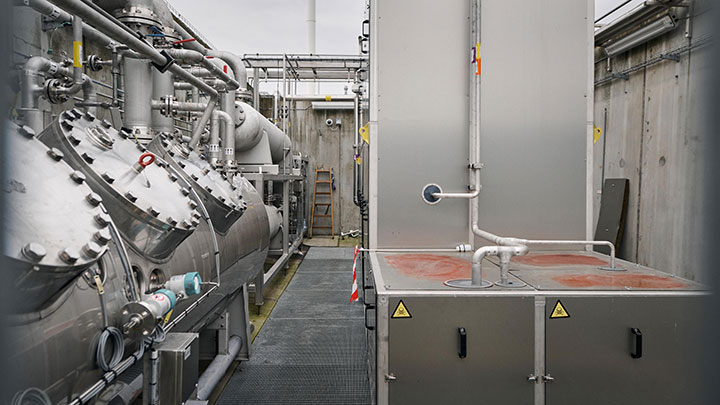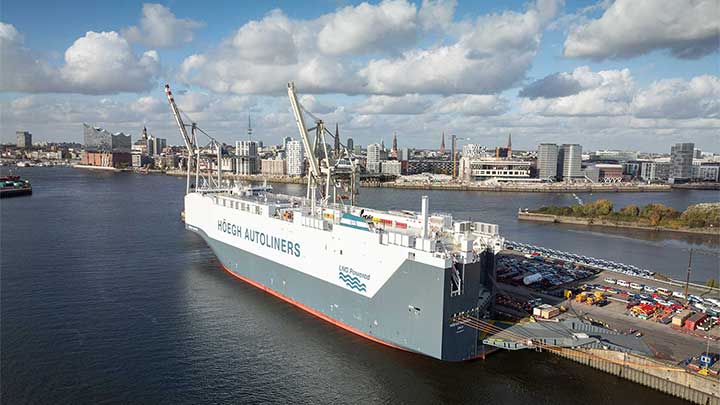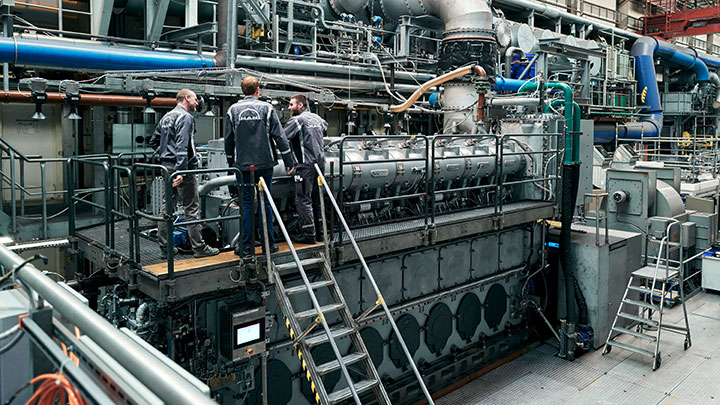Engineers are developing a two-stroke, dual-fuel ammonia engine that can move a ship’s emissions towards zero
Having developed a range of dual-fuel engines for greener fuels, MAN Energy Solutions' Research Centre Copenhagen (RCC) is pursuing the next milestone in achieving net-zero shipping: the first two-stroke ammonia marine engine. It's the story of how a toxic and pungent smelling chemical can make shipping greener.
By Niels Anner
The floor judders. Behind the glass panes here in the control room at RCC a tall two-stroke test engine starts working at full speed – emitting almost no carbon dioxide at all when running on ammonia. The RCC in the Danish capital’s old South Harbor has been working on the future of shipping for years. Its research and development specialists have improved ship engine efficiency and successfully converted engines to run on a number of cleaner fuels, such as liquefied natural gas (LNG) and green methanol.
Now, with this test engine, they have created a gamechanger in net-zero shipping: a 50-bore two-stroke dual-fuel engine that runs on carbon-free ammonia. “The goal of the engine is to reduce the greenhouse gas footprint by more than 90 percent compared to a standard diesel engine running on fuel oil,” says Brian Østergaard Sørensen, Vice President and Head of Two-Stroke R&D at MAN Energy Solutions. Compared to other green fuels, ammonia emits no CO2 at all during combustion. “The potential is huge,” says Østergaard Sørensen.
The goal of the engine is to reduce the greenhouse gas footprint by more than 90 percent.
“We’re expecting a significant demand for ammonia engines in the coming years,” says Bjarne Foldager, Head of Two-Stroke Business at MAN Energy Solutions. “And I think it's fair to say that we’re leading the way.” The first commercial engine is expected to be delivered by 2024 and installed in a ship in 2025. “In the next two years, we’ll see the first merchant ship in operation with our ammonia engine,” says Foldager.
Propelling car carriers and container ships with ammonia
Ammonia, along with other green fuels, is not only crucial for the maritime energy transition, but also benefits shipping with efficiency and pricing, says Thomas Hansen, Head of Two-Stroke Newsales & Promotion at MAN Energy Solutions. “Ammonia is a slow burning fuel. That’s why the two-stroke, slow-speed diesel cycle engine is ideal for burning it. And ammonia is expected to have the lowest production cost of all the green fuels.”
Ammonia is expected to have the lowest production cost of all the green fuels.
Green ammonia is produced by combining nitrogen pulled from the air and hydrogen separated from water using renewable electricity, and its production is expected to expand significantly in the coming years. And because ammonia is a frequently traded commodity mostly for use as a fertilizer, the infrastructure required for storage and transportation is available in many places.
The first ammonia-fueled engine is very flexible, says Hansen: “As a 60-bore engine, it will be well-suited to a wide range of different ship types.” He sees especially two kinds of vessels that could be the first to switch to ammonia: ships whose cargo is closely related to the end consumers, such as car carriers or container ships, and ammonia carriers. Also, retrofitting vessels with an ammonia engine will soon be a possibility, Bjarne Foldager explains: “We’re already in talks with the first potential projects for retrofit.“
Safety measures – at the test site and on board
Outside, a few hundred meters from the RCC, is a building that resembles a small white hangar. Inside, there is a tank holding five tons of ammonia, which is pumped into the test engine hall through secured pipes via the supply and recirculation system. Safety is paramount here, given the toxicity and pungent smell of ammonia.
Using this fuel here in the South Harbor, which is now a sought-after residential area with modern apartments around the corner, was a particular challenge: “We had to take extra safety precautions for the auxiliary system, the engine layout and the entire facility,” says Østergaard Sørensen. The solutions developed here also provide technology and onboard safety measures ensuring the crew on an ammonia-fueled ship can work safely. These include ammonia sensors, system ventilation, double-walled pipes, and special measures such as water screens to fully contain ammonia in the event of a leak.

One major challenge, Østergaard Sørensen explains, is already under control: When combusted, ammonia carries the risk of emitting laughing gas (nitrous oxide, N2O), which is a very potent greenhouse gas. “We manage this through engine tuning, and we’re seeing very low levels of laughing gas emissions.” The next big step in the development is to rebuild the engine for full-scale testing with four cylinders. “Then we’ll be able to verify the emissions and performance profile to make the engine ready for commercial use.”
We’ll provide the critical onboard technology, but it's very important that the production and supply of green fuels is ramped up at the same time.
From groundbreaking step to four cylinders
The ammonia project started in 2019 with a study, followed by the preparation of the infrastructure for supply and safety systems on both the engine and the site. Over the last year, the engine was modified, with one cylinder prepared to burn ammonia. In that process, the engineers at the RCC benefited from their many years of experience with dual-fuel engines: "Proven technology was upgraded,” says Østergaard Sørensen, “with technical changes on the injection equipment and engine control software.”
On 3 July 2023, the team reached a milestone on the way to the development of a full-scale two-stroke ammonia marine engine: the successful first run of the test engine on ammonia, with highly promising data on the stability of the combustion process. The focus is now on engine performance, pilot oil energy fraction, ignition and various emission categories.

For all the optimism at MAN Energy Solutions, it is clear that a positive development also depends on the shipping industry as a whole. To achieve net-zero shipping by 2050, new engines won't be enough, says Foldager. Ammonia and other green fuels will be more expensive than conventional ones, at least initially. “So, the industry needs global regulation, a CO2 tax or some other kind of compensation method to cover the additional costs.” That way, he stresses, the new ammonia engine will be able to realize its full potential to decarbonize shipping. “By committing to the ammonia engine development with the first engines on the water in 2026, we’re sending a clear signal to the industry.”
About the author
Niels Anner is an independent journalist based in Copenhagen, who writes on business, science, technology and society in Northern Europe.
MAN B&W two-stroke ammonia engine
The MAN B&W two-stroke ammonia engine will meet future market demands for green ship propulsion including retrofits. This makes it a valuable addition to the MAN B&W two-stroke dual-fuel engine portfolio. Gain further insights on the ammonia powered engine.
Explore more topics
-

Hoegh - LNG-powered car carrier
With its first LNG-powered car carrier, Höegh Autoliners is taking a big step towards its target of net-zero by 2040. The centerpiece of the vessel is a MAN Energy Solutions MAN B&W ME-GI dual-fuel engine.
-

Maersk Halifax Retrofit
The world’s first methanol retrofit of the Very Large Container Vessel Maersk Halifax opens the doors for green fuels.
-

Methanol dual fuel retrofit
Engineers are now testing a retrofit for four-stroke ship engines that will enable ferry and cruise ship operators to meet the growing requirements on emission reduction with green methanol.
MAN Energy Solutions is now Everllence.
We have adopted a new brand name and moved to a new domain: www.everllence.com. This page will also be relocated there shortly. We are working on shifting all pages to www.everllence.com.
